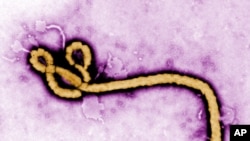Starting in 2014, West Africa experienced the largest Ebola outbreak in history, killing more than 11,000 people and bringing the threat of global pandemic to worldwide consciousness. Scientists believe the outbreak started with a small boy who contracted the virus from a bat.
But Ebola is hardly the only disease caused by microbes transferred between animals and humans, and as the global population continues to grow, along with demand for food, similar threats are likely to arise.
Tuesday at a hotel in Nairobi, the U.N. Food and Agriculture Organization and the U.S. Agency for International Development launched the East African component of FAO’s Emerging Pandemic Threats, or EPT-2 program. The program is designed to help detect, prevent, and control new "zoonotic" diseases, meaning those which can be passed between animals and humans.
Subhash Morzaria is the global coordinator of the EPT-2 program at FAO. He said these diseases can be transmitted through the air or by touching infected fluids or materials.
“Whatever the mode of transmission ... if these infectious diseases persist in our animal populations, then we have a constant risk of this disease potentially becoming pandemic and causing huge, huge outbreaks and morbidity and mortality in humans, and in animals as well,” said Morzaria.
Ebola is only one of the zoonotic diseases. Others include HIV and AIDS, influenza, including those commonly known as avian flu and swine flu, and SARS, MERS-CoV, Marburg, and Nipah.
According to the U.S. Centers for Disease Control and Prevention, an estimated six out of every 10 infectious diseases in humans are spread from animals.
More people, more risk
The United Nations projects that the world’s current population of 7.3 billion people will reach 9.7 billion in 2050. This rapid increase in the number of people means that the demand for food will also rise.
“Now these production systems will change very rapidly to meet this demand, and it’s possible that some very risky practices in the production of livestock might occur, and these risky practices might create an environment for evolution of new pathogens and spread,” FAO’s Morzaria said.
Kenya’s director of veterinary services, Dr. Kisa Juma Ngeiywa, said new pathogens can spread further than ever in today’s mobile society.
“Let me use the H7N9 influenza, which was in China,” said Ngeiywa. “That is a disease, one of the influenzas on live bird markets. Now, if you look at the airplanes, Kenya Airways, Ethiopian Airlines, and others, they are going to China and they are coming to Kenya, every day. So, because of that there is a big vulnerability, unless we put measures to be able to see and stop it from spreading.”
And Morzaria said that everyone has a stake in the process.
“Everybody is at threat. The virus doesn’t distinguish between a poor and a rich person. It goes and infects and it kills that person if it’s highly infectious and pathogenic,” he said. “So I think this is a global concern.”
In October, USAID announced $87 million in new funding for the program. The money will be used to help governments and veterinary services better understand livestock systems and to help conduct proactive surveillance, as well as identifying current and potential pathogens.








